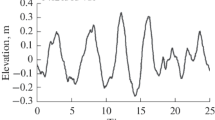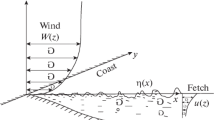Abstract
The aim of this work is to obtain estimates and parameterization of the dissipation rate of the turbulence kinetic energy (TKE dissipation), ε, induced in the upper water layer by the presence of wind waves at the surface. For this purpose, data from the laboratory measurements of the wind waves and three components of currents at six horizons in the upper water layer and four different winds are used. The measurements are performed in the wind-wave channel of the Institute of Applied Physics, Russian Academy of Sciences (IAP RAS) [1, 2]. It is established that, for most horizons, Kolmogorov-type ranges with the property \({{S}_{{Uz}}}(f) \propto {{f}^{{ - 5/3}}}\) are clearly seen in the frequency spectra \({{S}_{{Uz}}}(f)\) for the vertical velocity component Uz of the flow induced by wind and waves. Using the algorithms described in [3, 4], this fact allows us to obtain estimates of the TKE dissipation at the corresponding horizons and then establish the dependence of ε on the friction velocity \({{u}_{*}}\), the height of waves at the surface a0, the peak frequency of the spectrum ωp, and the depth of the horizon z. An analysis of the results (according to the available data) makes it possible to propose a parameterization of the form ε ≈ 0.00025\(u_{*}^{3}{{a}_{0}}/{{z}^{2}}\) for which a physical interpretation is proposed.



Similar content being viewed by others
Notes
Here, we note that the dependence \(\varepsilon \propto a_{0}^{3}\) was obtained in the case of mechanical wave on the surface in the experiment [15]. This experiment requires a special consideration due to the absence of wind.
REFERENCES
A. A. Kandaurov, Yu. I. Troitskaya, Sergeev, M. I. Vdovin, and G. A. Baidakov, “Average velocity field of the air flow over the water surface in a laboratory modeling of storm and hurricane conditions in the ocean,” Izv., Atmos. Ocean. Phys. 50 (4), 399–410 (2014). https://doi.org/10.7868/S0002351514040063
G. A. Baidakov, Candidate’s Dissertation in Physics and Mathematics (Institute of Applied Physics, Russian Academy of Sciences, 2016).
J. L. Lumley and E. A. Terrey, “Kinematics of turbulence convected by a radom wave field,” J. Phys. Oceanogr. 13, 2000–2007 (1983).
E. A. Terra, M. A. Donelan, Y. C. Agrawal, W. M. Drennan, K. K. Kahma, A. J. Williams III, P. A. Hwang, and S. A. Kitaigorodskii, “Estimates of kinetic energy dissipation under breaking waves,” J. Phys. Oceanogr. 26, 792–807 (1996).
S. V. Dobroklonskii, “Turbulent viscosity in the near-surface layer of the sea,” Dokl. Akad. Nauk SSSR 58 (7), 1345–1349 (1947).
O. M. Phillips, “A note of the turbulence generated by the gravity waves,” J. Geophys. Res. 66, 2889–2893 (1961).
S. A. Kitaigorodskii and J. L. Lumley, “Wave–turbulence interaction in the upper ocean. Pt. I. The energy balance in the interacting fields of surface waves and wind-induced three-dimensional turbulence,” J. Phys. Oceanogr. 13, 1977–1987 (1983).
G. L. Mellor and T. Yamada, “Development of a turbulence closure model for geophysical fluid problems,” Rev. Geophys. Space Phys. 20, 851–875 (1982).
O. M. Phillips, The Dynamics of the Upper Ocean (Cambridge, Cambridge University Press, 1977; Gidrometeoizdat, Leningrad, 1980).
R. W. Stewart and H. L. Grant, “Determination of the rate of dissipation of turbulent energy near the sea surface in the presence of waves,” J. Geophys. Res. 67, 3177–3180 (1962).
A. Anis and J. N. Moum, “Surface wave–turbulence interactions: Scaling ε(z) near the sea surface,” J. Phys. Oceanogr. 25, 2025–2045 (1995).
A. V. Soloviev, “On the dissipation of turbulent energy in the wind wave layer of the ocean,” Izv. Akad. Nauk SSSR: Fiz. Atmos. Okeana 22 (4), 380–388 (1986).
A. V. Soloviev, N. V. Vershinsky, and V. A. Bezverchnii, “Small-scale turbulence in the thing surface layer of the ocean,” Deep-Sea Res. 35, 1859–1874 (1988).
A. Soloviev and R. Lukas, “Observation of wave-enhanced turbulence in the near-surface layer of the ocean during TOGA COARE,” Deep-Sea Res. 50, 371–395 (2003). https://doi.org/10.1016/S0967-0637(03)00004-9
A. V. Babanin and B. K. Haus, “On the existence of water turbulence induced by non-breaking surface waves,” J. Phys. Oceanogr. 39, 2675–2679 (2009). https://doi.org/10.1175/2009JPO4202.1
Y. Yuan, F. Qiao, X. Yin, and L. Han, “Analytical estimation of mixing coefficient induced by surface wave-generated turbulence based on the equilibrium solution of the second-order turbulence closure model,” Sci. China: Earth Sci. 56, 71–80 (2013). https://doi.org/10.1007/s11430-012-4517-x
A. M. Chukharev, Doctoral Dissertation in Physics and Mathematics (Marine Hydrophysical Institute, Russian Academy of Sciences, Sevastopol, 2014).
V. G. Polnikov, A model of the enhanced vertical mixing induced by wind-waves. http://arxiv.org/abs/1904.03609.
F. Qiao, Y. Yuan, J. Deng, D. Dai, and Z. Song, “Wave–turbulence interaction-induced vertical mixing and its effects in ocean and climate models,” Philos. Trans. R. Soc. A374, 20150201 (2016). https://doi.org/10.1098/rsta.2015.0201
K. Walsh, P. Govekar, A. V. Babanin, M. Ghantous, P. Spence, and F. Scoccimarro, “The effect on simulated ocean climate of a parameterization of unbroken wave-induced mixing incorporated into the k-epsilon mixing scheme,” J. Adv. Model. Earth Syst. 9, 735–758 (2017). https://doi.org/10.1002/2016MS000707
A. S. Monin and A. Ya. Yaglom, Statistical Hydromechanics (Nauka, Moscow, 1967), Vol. 2 [in Russian].
V. V. Efimov and G. N. Khristoforov, “Spectra and characteristics of statistical correlation between velocity pulsations in the upper layer of the sea and surface waves,” Izv. Akad. Nauk SSSR: Fiz. Atmos. Okeana 7 (12), 1290–1310 (1971).
S. Longo, L. Chiapponi, M. Clavero, T. Makel, and D. Liang, “Study of the turbulence over the air-side and water-side boundary layers in experimental laboratory wind-induced surface waves,” Coastal Eng. 69, 67–81 (2012).
E. V. Mortikov, A. V. Glazunov, and V. N. Lykosov, “Numerical study of plane Couette flow: Turbulence statistics and the structure of pressure-strain correlations,” Russ. J. Numer. Anal. Math. Modell. 34 (2), 119–132 (2019).
S. M. Kay and S. L. Marple, “Spectrum analysis—A modern perspective,” Proc. IEEE 69 (11), 1380–1419 (1981).
V. G. Polnikov, “A semi-phenomenological model for wind-induced drift currents,” Boundary-Layer Meteorol. 172 (3), 417–433 (2019). https://doi.org/10.1007/s10546-019-00456-1
ACKNOWLEDGMENTS
We are grateful to colleagues from the Institute of Applied Physics taking part in the experiments.
Funding
This work was supported by the Russian Foundation for Basic Research, project no. 18-05-00161.
Author information
Authors and Affiliations
Corresponding author
Additional information
Translated by A. Nikol’skii
Rights and permissions
About this article
Cite this article
Polnikov, V.G., Baidakov, G.A. & Troitskaya, Y.I. Dissipation Rate of Turbulence in a Water Layer under Wind Waves Based on Data of a Laboratory Experiment. Izv. Atmos. Ocean. Phys. 55, 492–501 (2019). https://doi.org/10.1134/S0001433819050104
Received:
Revised:
Accepted:
Published:
Issue Date:
DOI: https://doi.org/10.1134/S0001433819050104




